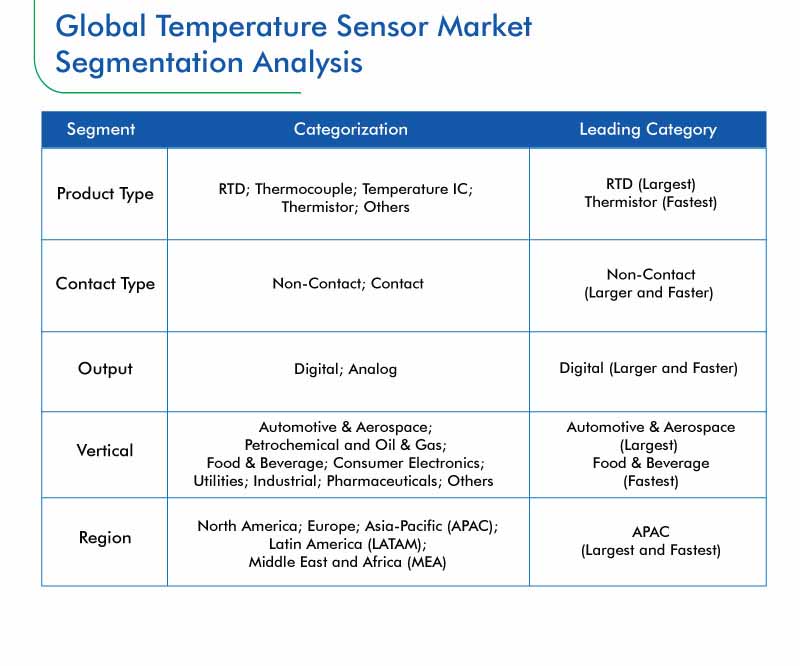Temperature Sensor Market to Generate Revenue of $11.1 Billion by 2030
- Published: April 2020
The expanding automobile industry and increasing sale of smartphones are the major reasons behind the rising demand for temperature sensors. Driven by these factors, the global temperature sensor market is expected to grow to $11.1 billion by 2030, from $6.9 billion in 2019, at a 4.4% CAGR during 2020–2030 (forecast period).
Temperature Sensor Market Segmentation

During the forecast period, the thermistor category is expected to witness the fastest growth in the temperature sensor market, owing to the numerous advantages these devices offer end uses, such as low cost, high sensitivity, ease of use, faster response rate, small size, and the flexibility to be customized.
The automotive & aerospace division held the largest share in the market in 2019, on account of the stringent government regulations that mandate the use of temperature sensors in automobiles. This has been done to make the vehicle more efficient in terms of fuel consumption, primarily owing to the extreme level of pollution in the air and strong nee to decrease the emission of greenhouse gases (GHG) from vehicles. Further, with the growing automotive industry and aftermarket, the demand for such instruments is rising. The petrochemical and oil & gas sector was the second largest market for temperature sensors in 2019, as measuring the temperature of the oil in tanks is rather important.
During the historical period (2014–2019), Asia-Pacific (APAC) dominated the temperature sensor market, as the sale of automobiles and smartphone and the rate of urbanization are rapidly increasing in the region, particularly in China and India. Within the region, China is the largest market for such devices, while on the global basis, it ranks second, after the U.S.
Market Players Launching New Products to Dominate Competition
Players in the temperature sensor market are quickly introducing new products to gain a larger customer base and increase their profits. For instance, in February 2020, Heilind Electronics, which offers switches, connectors, terminal blocks relays, and wires and cables, unveiled the 5024 EGR temperature sensor, which is based on the negative temperature coefficient (NTC) technology; it is accurate up to 300 degree Celsius.
Browse report overview with detailed TOC on "Temperature Sensor Market Research Report: By Product Type (Temperature IC, Thermistor, RTD, Thermocouple), Contact Type (Contact, Non-Contact), Output (Analog, Digital), Vertical (Automotive and Aerospace, Petrochemical and Oil & Gas, Consumer Electronics, Food & Beverage, Pharmaceuticals, Utilities, Industrial) - Global Industry Analysis and Growth Forecast to 2030" at:https://www.psmarketresearch.com/market-analysis/temperature-sensor-market
In the same vein, in February 2019, an ultra-compact digital temperature sensor was brought to the market by TE Connectivity Ltd. Available in two sizes — 2.5 mm x 2.5mm and 1.5mm x 1.5mm and — the instrument and multi-channel digital output, and its power consumption is also low. With this product launch, which targets medical, industrial, consumer, and automotive users, the company has aimed at strengthening its position in the industry.
The key global temperature sensor market players include Infineon Technologies AG, Honeywell International Inc., TE Connectivity Ltd., ABB Ltd., NXP Semiconductors N.V., Texas Instruments Incorporated, STMicroelectronics N.V., Panasonic Corporation, Amphenol Corporation, Robert Bosch GmbH, Analog Devices Inc., and On Semiconductor Corporation.